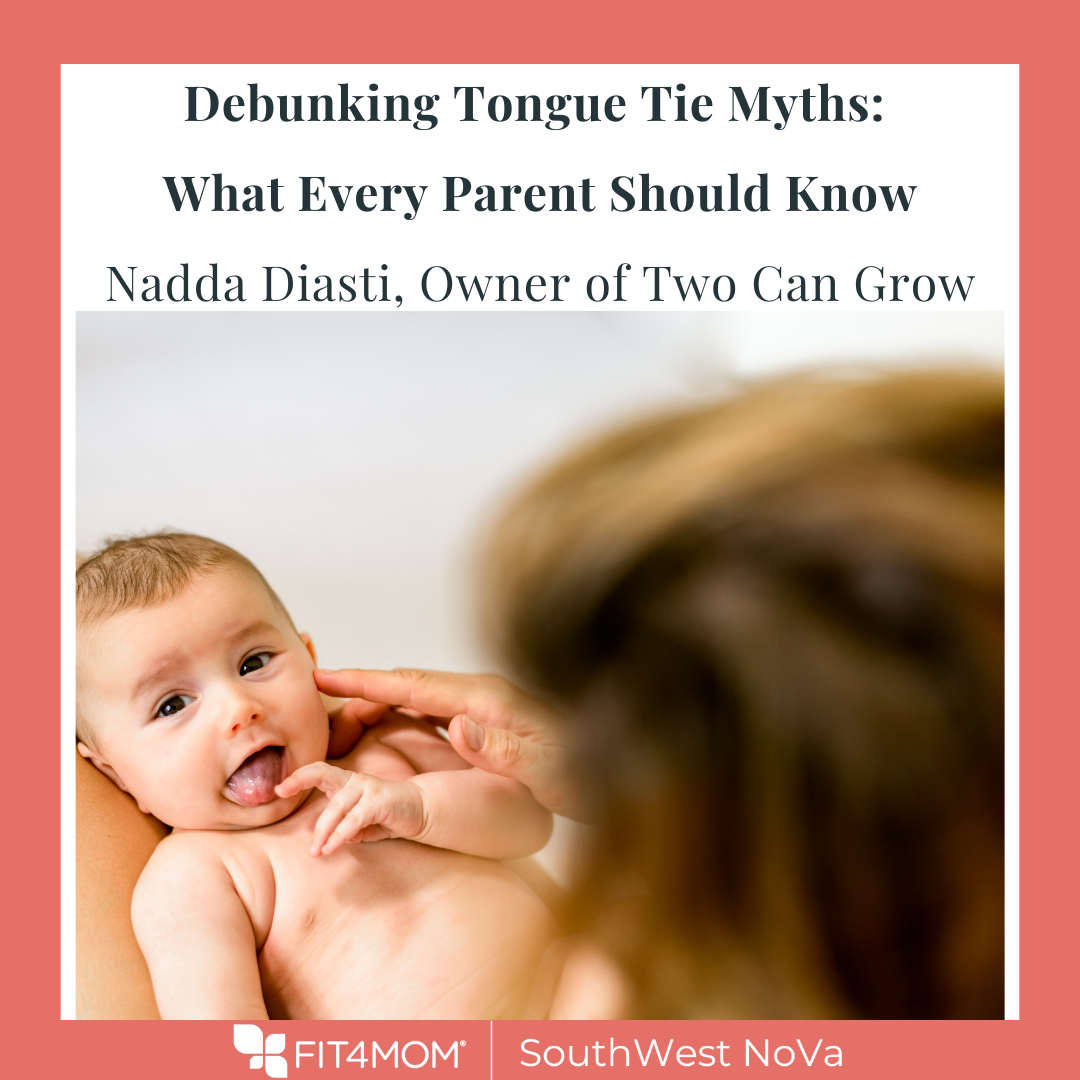Feeding your baby isn’t always as straightforward as you might expect—and when a provider mentions a “tongue tie,” it can lead to even more questions and uncertainty. With so much conflicting information and advice online, it’s easy to feel overwhelmed. That’s why I want to help clear up a few of the most common myths I hear about tongue ties.
Hi, I’m Nadda Diasti—owner of Two Can Grow and a speech-language pathologist, feeding therapist, lactation consultant, and sleep coach based in Vienna, VA. I help babies feed, feel, and move better, so parents can rest easier. One of my areas of specialty is assessing and supporting infants with tongue and lip ties!
Before we dive into the myths, let’s make sure we’re all on the same page—what exactly is a tongue tie?
Tethered Oral Tissues (TOTs)—which include tongue, lip, and cheek ties—are congenital formations that restrict range of motion and mobility in the mouth. We all have 7 frenula in our mouth:
1 lingual (tongue) frenulum, located under the tongue
2 labial (lip) frenula: located on the upper lip and lower lip
4 buccal (cheek) frenula, located in each quadrant of the mouth
These restrictions can affect a baby’s ability to feed efficiently, and may also contribute to challenges with sleep, airway, oral facial development and more.
A diagnosis of tongue, lip, and/or cheek tie is only given if/when functional challenges are present with feeding, sleep, airway, etc.
Myth 1: Tongue ties are just a fad.
While it might feel like everyone is suddenly talking about ties, they have actually been recognized for centuries! Today, there has been an increase in awareness and education for both professionals and parents. Recently, there have been initiatives such as The Baby Friendly Initiative to increase numbers of babies being breastfed. As a result, more mothers are informed, are able to identify when something doesn’t feel quite right, and are seeking support when experiencing feeding challenges.
At the same time, more providers are pursuing specialized training to better understand ties, their impact, and how to assess, diagnose, and treat them. While ties may seem like a fad, current research suggests the prevalence of ties ranges between 4-11%.
Myth 2: It’s not a tie if baby can stick their tongue out
While some infants with tongue ties are unable to protrude their tongue, there are others who can! Tongue movement is more complex than simple protrusion (in & out movement) and it is not an indicator of a tongue tie being present. A thorough functional assessment must be completed to assess for range of motion of the tongue in ALL directions. The most important movement for the tongue during feeding is lateral movements (side to side), up and down, and peristaltic waves - not just in and out.
You can take a look at what ‘optimal’ function for feeding looks like here!
Myth 3: The ties will stretch over time.
Ties are like webbed fingers, they don't stretch with time. Webbed fingers are unable to move freely and as you grow, your fingers stay tethered together. The tongue is similar; ties are a webbing of fascia/connective tissue that lead to symptoms and functional challenges. In fact, research shows that frenulum of tongue tied individuals are composed of type I collagen fibers that are only able to stretch 3%, this will make minimal change in a baby’s function. Our bodies are good at learning to compensate, and unfortunately babies grow into more compensations rather than ‘growing out of it.’
Myth 4: Ties only impact breastfeeding
For some, untreated tongue ties can have a range of implications from infancy through adulthood. Areas that can be impacted in addition to breastfeeding include:
Bottle feeding
Oral facial development
Sleep quality (e.g., restless sleep, mouth breathing, snoring, bedwetting, grinding teeth)
Prolonged oral habits (thumb/finger, paci sucking)
Body tension
Dental malocclusion
Transitioning to solids + difficulty progressing through textures
Picky eating
Poor speech intelligibility due to difficulty producing certain speech sounds (e.g., /t, d, n, l, r/)
Behavior challenges
Ties should never be released to ‘prevent’ future challenges from arising. Instead, we want to determine the need for release based on what is presently being impacted.
Myth 5: Your pediatrician may not be well-versed in addressing the presence of Ties
Most pediatricians, while incredibly skilled in various aspects of a child’s health and well being, do not receive training in assessing and identifying the presence of ties. In fact, this area is not taught in most grad programs either, this includes SLPs, OTs, and IBCLCs too. I pivoted my career to invest countless hours into receiving continuous education and training to specialize in this area. And the truth is pediatricians typically do not have the time to complete a comprehensive assessment in a short check-up appointment.
A consultation with a skilled tie savvy provider can give you clarity and support. If you have concerns, an evaluation with a preferred provider is your best first step to addressing your concerns.
If you suspect your baby or toddler has a tie:
Download your free tongue tie screener here
Book a 1:1 consultation at my office in Vienna, VA. Contact me today
Join our FREE bi-weekly Feeding + Milestones meetup - save your spot today
You never have to navigate this alone!

